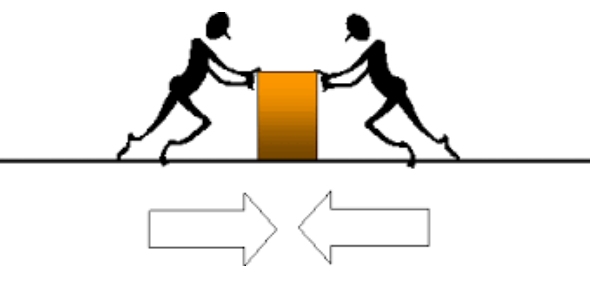A push or pull exerted by an object on another is a force.
Force arises due to the interaction between at least two objects.
Force has both Magnitude and Direction
- Force applied on an object in the same direction add to one another.
- If the two forces act in the opposite direction on an object, the net force acting on it is the difference between the two forces.
- In general, more than one force may be acting on an object at any given point. However, a force acting on an object is always the mean net force acting on it.
A Force can Change the State of Motion
- A change in the speed of an object or the direction of its motion or both implies a change in its state of motion.
- Force acting on an object may bring a change in its state of motion or a change in its shape.
To move a tyre faster it has to be pushed repeatedly
A magnet can exert a force without being in contact with it. The force exerted by a magnet is an example of a non-contact force.
Thrust: The force that acts on a surface in a direction perpendicular to it, is known as thrust.
Pressure: Thrust per unit area is called pressure. So, pressure = force/area on which it acts.
Liquids exert pressure on the walls of the container in which they are kept.
Gases exert pressure in all directions.
Electrostatic force: A force exerted by a charged body on another charged or uncharged body is known as electrostatic force.
Atmospheric pressure is defined as the pressure exerted on a surface by the weight of air above that surface.
Atmospheric Pressure: The pressure exerted by atmospheric air around us is known as atmospheric pressure.
Contact Force: A force that can be applied only when it is in contact with an object is called a contact force. For example, hammering a nail.
Electrostatic Force: When a charged body, either having a (+) or (-) charge, exerts force on another charged or uncharged body, that force is known as electrostatic force.
Force: Simply a push or pull exerted by an object on another is a force.
Friction: The force of friction always acts on all the moving objects and its direction is always opposite to the direction of motion.
Gravitational Force: The force exerted by the earth to pull the objects towards itself is called the force of gravity.
Gravity: Every object in the universe, whether small or large, exerts a force on every other object. This force is called the force of gravity or just gravity.
Magnetic Force: The force exerted by a magnet to pull/push a metallic object is called magnetic force.
Muscular Force: The force resulting due to the action of muscles is known as muscular force. For example, writing, cutting vegetables.
Non-Contact Forces: A force that can be applied without any contact between two objects is called non-contact force. For example, the magnet pulls the iron-pieces.
Pressure: The force acting on per unit area, applied to an object in the direction perpendicular to the surface is called pressure.

ncert solutions


